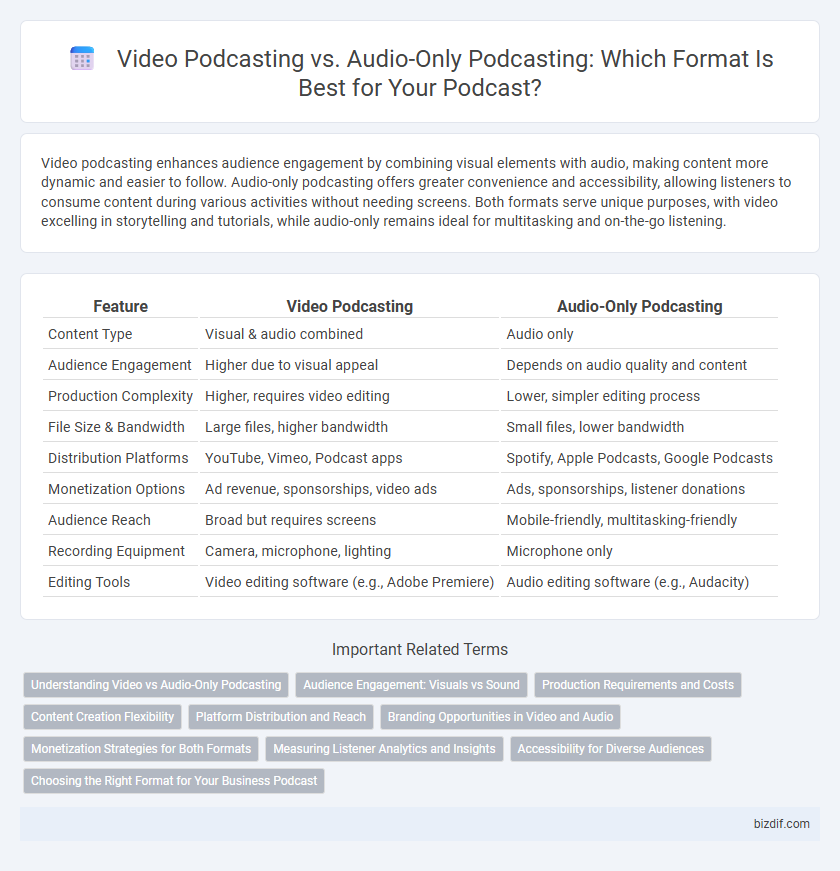Video podcasting enhances audience engagement by combining visual elements with audio, making content more dynamic and easier to follow. Audio-only podcasting offers greater convenience and accessibility, allowing listeners to consume content during various activities without needing screens. Both formats serve unique purposes, with video excelling in storytelling and tutorials, while audio-only remains ideal for multitasking and on-the-go listening.
Table of Comparison
| Feature | Video Podcasting | Audio-Only Podcasting |
|---|---|---|
| Content Type | Visual & audio combined | Audio only |
| Audience Engagement | Higher due to visual appeal | Depends on audio quality and content |
| Production Complexity | Higher, requires video editing | Lower, simpler editing process |
| File Size & Bandwidth | Large files, higher bandwidth | Small files, lower bandwidth |
| Distribution Platforms | YouTube, Vimeo, Podcast apps | Spotify, Apple Podcasts, Google Podcasts |
| Monetization Options | Ad revenue, sponsorships, video ads | Ads, sponsorships, listener donations |
| Audience Reach | Broad but requires screens | Mobile-friendly, multitasking-friendly |
| Recording Equipment | Camera, microphone, lighting | Microphone only |
| Editing Tools | Video editing software (e.g., Adobe Premiere) | Audio editing software (e.g., Audacity) |
Understanding Video vs Audio-Only Podcasting
Video podcasting offers a visually engaging experience by combining audio with dynamic visuals, enhancing audience connection through facial expressions and on-screen content. Audio-only podcasting prioritizes accessibility and convenience, allowing listeners to consume content hands-free during commutes or multitasking. Choosing between video and audio formats depends on factors like target audience preferences, content type, production resources, and desired listener engagement.
Audience Engagement: Visuals vs Sound
Video podcasting enhances audience engagement by combining visuals with sound, allowing for richer storytelling through facial expressions, body language, and on-screen graphics that captivate viewers. Audio-only podcasting relies solely on sound, emphasizing vocal tone, music, and sound effects to create immersive experiences that encourage imagination and personal interpretation. While video appeals to visual learners and can increase viewer retention, audio-only formats offer greater accessibility and convenience for multitasking audiences.
Production Requirements and Costs
Video podcasting demands higher production requirements, including upgraded cameras, lighting, and video editing software, which significantly increase costs compared to audio-only podcasting. Audio-only formats require less equipment, such as quality microphones and audio editing tools, making them more budget-friendly and accessible for beginners. The additional time and resources needed for video post-production contribute to the overall expense and complexity of video podcasting compared to purely audio-based content.
Content Creation Flexibility
Video podcasting offers greater content creation flexibility by enabling visual storytelling, on-screen demonstrations, and enhanced audience engagement through facial expressions and body language. Audio-only podcasting excels in ease of production, lower costs, and accessibility, allowing creators to record anytime, anywhere without concern for lighting or visual setup. Both formats cater to diverse content strategies, with video podcasts suited for tutorials and interviews while audio-only podcasts prioritize convenience and portability for listeners.
Platform Distribution and Reach
Video podcasting benefits from platforms like YouTube and Vimeo, which offer vast audiences and enhanced discoverability through visual search algorithms. Audio-only podcasting thrives on traditional platforms such as Apple Podcasts, Spotify, and Google Podcasts, ensuring broad reach among listeners who prefer convenience and background listening. Choosing the right format depends on target audience preferences and platform-specific distribution strengths to maximize engagement and growth.
Branding Opportunities in Video and Audio
Video podcasting enhances branding opportunities by allowing visual elements such as logos, color schemes, and on-screen personalities to reinforce brand identity, creating stronger audience recognition. Audio-only podcasting relies heavily on voice, tone, and sound design to convey brand personality, which can foster intimacy and listener loyalty but lacks visual brand reinforcement. Both formats offer unique branding advantages, with video providing multi-sensory engagement and audio focusing on immersive storytelling and emotional connection.
Monetization Strategies for Both Formats
Video podcasting often enables higher monetization opportunities through visual ads, product placements, and sponsorships that leverage on-screen branding. Audio-only podcasting primarily relies on dynamic ad insertion, listener donations, and subscription models, capitalizing on ease of consumption and broader audience reach. Combining both formats can diversify revenue streams, optimizing listener engagement and advertiser appeal.
Measuring Listener Analytics and Insights
Video podcasting offers enhanced listener analytics through visual engagement metrics, such as watch time, viewer drop-off points, and facial expression analysis, providing deeper insights into audience behavior. Audio-only podcasting primarily relies on play counts, listener retention rates, and geographic data, which offer valuable but less granular insights compared to video formats. Leveraging advanced analytics tools tailored to each medium enables podcasters to optimize content strategy and enhance listener engagement effectively.
Accessibility for Diverse Audiences
Video podcasting enhances accessibility by incorporating visual elements such as sign language interpretation, on-screen captions, and descriptive graphics, catering to diverse audiences including those with hearing impairments. Audio-only podcasting offers portability and ease of consumption for visually impaired individuals or multitasking listeners, supporting accessibility through advanced audio clarity and navigational features. Combining both formats ensures broader reach and inclusivity, addressing the varied accessibility needs of different audience segments.
Choosing the Right Format for Your Business Podcast
Video podcasting enhances audience engagement by integrating visual elements, making it ideal for brands aiming to build personal connections and showcase products. Audio-only podcasting offers greater flexibility and easier production, suiting businesses targeting commuters or multitaskers seeking content on the go. Selecting the right format depends on your target audience's preferences, content complexity, and resource availability for production and editing.
Video Podcasting vs Audio-Only Podcasting Infographic

 bizdif.com
bizdif.com